
A neurotransmitter receptor is a membrane receptor protein that is activated by a neurotransmitter. Chemicals on the outside of the cell, such as a neurotransmitter, can bump into the cell's membrane, in which there are receptors. If a neurotransmitter bumps into its corresponding receptor, they will bind and can trigger other events to occur inside the cell. Therefore, a membrane receptor is part of the molecular machinery that allows cells to communicate with one another. A neurotransmitter receptor is a class of receptors that specifically binds with neurotransmitters as opposed to other molecules.

Buspirone, sold under the brand name Buspar, among others, is a medication primarily used to treat anxiety disorders, particularly generalized anxiety disorder. Benefits support its short-term use. It is taken by mouth, and it may take up to four weeks to have an effect.

Pindolol, sold under the brand name Visken among others, is a nonselective beta blocker which is used in the treatment of hypertension. It is also an antagonist of the serotonin 5-HT1A receptor, preferentially blocking inhibitory 5-HT1A autoreceptors, and has been researched as an add-on therapy to selective serotonin reuptake inhibitors (SSRIs) in the treatment of depression.
An autoreceptor is a type of receptor located in the membranes of nerve cells. It serves as part of a negative feedback loop in signal transduction. It is only sensitive to the neurotransmitters or hormones released by the neuron on which the autoreceptor sits. Similarly, a heteroreceptor is sensitive to neurotransmitters and hormones that are not released by the cell on which it sits. A given receptor can act as either an autoreceptor or a heteroreceptor, depending upon the type of transmitter released by the cell on which it is embedded.

Amisulpride is an antiemetic and antipsychotic medication used at lower doses intravenously to prevent and treat postoperative nausea and vomiting; and at higher doses by mouth to treat schizophrenia and acute psychotic episodes. It is sold under the brand names Barhemsys and Solian, Socian, Deniban and others. At very low doses it is also used to treat dysthymia.
A heteroreceptor is a receptor regulating the synthesis and/or the release of mediators other than its own ligand.
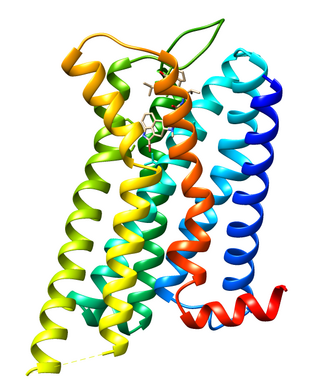
Dopamine receptor D2, also known as D2R, is a protein that, in humans, is encoded by the DRD2 gene. After work from Paul Greengard's lab had suggested that dopamine receptors were the site of action of antipsychotic drugs, several groups, including those of Solomon Snyder and Philip Seeman used a radiolabeled antipsychotic drug to identify what is now known as the dopamine D2 receptor. The dopamine D2 receptor is the main receptor for most antipsychotic drugs. The structure of DRD2 in complex with the atypical antipsychotic risperidone has been determined.

The serotonin 1A receptor is a subtype of serotonin receptor, or 5-HT receptor, that binds serotonin, also known as 5-HT, a neurotransmitter. 5-HT1A is expressed in the brain, spleen, and neonatal kidney. It is a G protein-coupled receptor (GPCR), coupled to the Gi protein, and its activation in the brain mediates hyperpolarisation and reduction of firing rate of the postsynaptic neuron. In humans, the serotonin 1A receptor is encoded by the HTR1A gene.

5-Hydroxytryptamine (serotonin) receptor 5A, also known as HTR5A, is a protein that in humans is encoded by the HTR5A gene. Agonists and antagonists for 5-HT receptors, as well as serotonin uptake inhibitors, present promnesic (memory-promoting) and/or anti-amnesic effects under different conditions, and 5-HT receptors are also associated with neural changes.

AR-A000002 is a drug which is one of the first compounds developed to act as a selective antagonist for the serotonin receptor 5-HT1B, with approximately 10x selectivity for 5-HT1B over the closely related 5-HT1D receptor. It has been shown to produce sustained increases in levels of serotonin in the brain, and has anxiolytic effects in animal studies.

SB-699551 is a drug which was the first compound developed to act as a selective antagonist for the serotonin receptor 5-HT5A, with selectivity of around 100x over other serotonin receptor subtypes. Multiple therapeutic roles have been suggested for 5-HT5A ligands due to the presence of this receptor in several areas of the brain, but research is still at an early stage, In animal studies, SB-699551 was found to block cue-mediated responding to LSD, again suggesting an antipsychotic type of activity. It also reduces the viability of certain types of cancer cells in vitro, suggesting the 5-HT5A receptor as a possible target for novel chemotherapy drugs.

SB-216641 is a drug which is a selective antagonist for the serotonin receptor 5-HT1B, with around 25x selectivity over the closely related 5-HT1D receptor. It is used in scientific research, and has demonstrated anxiolytic effects in animal studies.
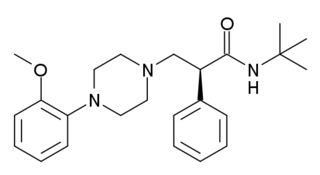
WAY-100135 is a serotonergic drug of the phenylpiperazine family which is used in scientific research. It acts as potent 5-HT1A receptor antagonist, and was originally believed to be highly selective, but further studies have demonstrated that it also acts as a partial agonist of the 5-HT1D receptor (pKi = 7.58; virtually the same affinity for 5-HT1A), and to a much lesser extent, of the 5-HT1B receptor (pKi = 5.82). These findings may have prompted the development of the related compound WAY-100635, another purportedly selective and even more potent 5-HT1A antagonist, which was synthesized shortly thereafter. However, WAY-100635 turned out to be non-selective as well, having been shown to act additionally as a potent D4 receptor agonist later on.
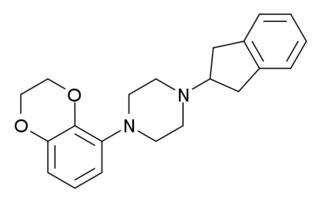
S-15535 is a phenylpiperazine drug which is a potent and highly selective 5-HT1A receptor ligand that acts as an agonist and antagonist at the presynaptic and postsynaptic 5-HT1A receptors, respectively. It has anxiolytic properties.
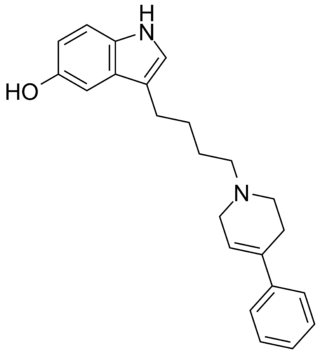
Roxindole (EMD-49,980) is a dopaminergic and serotonergic drug which was originally developed by Merck KGaA for the treatment of schizophrenia. In clinical trials its antipsychotic efficacy was only modest but it was unexpectedly found to produce potent and rapid antidepressant and anxiolytic effects. As a result, roxindole was further researched for the treatment of depression instead. It has also been investigated as a therapy for Parkinson's disease and prolactinoma.

CP-93129 is a drug which acts as a potent and selective serotonin 5-HT1B receptor agonist, with approximately 150x and 200x selectivity over the closely related 5-HT1D and 5-HT1A receptors. It is used in the study of 5-HT1B receptors in the brain, particularly their role in modulating the release of other neurotransmitters.
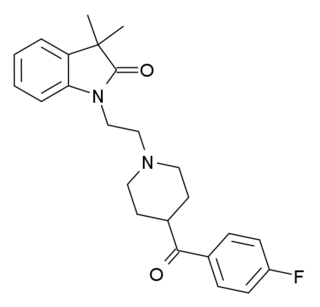
LY-310762 is a drug which acts as a potent and selective antagonist for the 5-HT1D serotonin receptor, with reasonable selectivity over the closely related 5-HT1B subtype.

SB-236057 is a compound which is a potent and selective inverse agonist for the serotonin receptor 5-HT1B, acting especially at 5-HT1B autoreceptors on nerve terminals. It produces a rapid increase in serotonin levels in the brain, and was originally researched as a potential antidepressant. However subsequent research found that SB-236,057 also acts as a potent teratogen, producing severe musculoskeletal birth defects when rodents were exposed to it during pregnancy. This has made it of little use for research into its original applications, yet has made it useful for studying embryonic development instead.

LY-456219 is a potent and selective serotonin 5-HT1D receptor antagonist which has been used in research to study the function of presynaptic 5-HT1D autoreceptors. LY-456219 lacks significant affinity for the 5-HT1B, α1 adrenergic, and dopamine D2 receptors.

LY-456220 is a potent and selective serotonin 5-HT1D receptor antagonist which has been used in research to study the function of presynaptic 5-HT1D autoreceptors. LY-456220 lacks significant affinity for the 5-HT1B, α1 adrenergic, and dopamine D2 receptors.


















